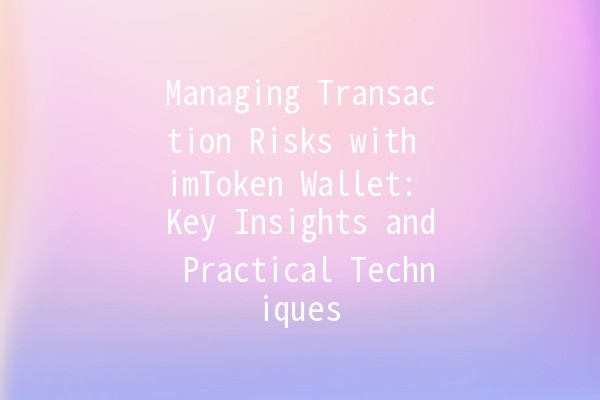The rise of cryptocurrency has brought with it a multitude of opportunities, but it also carries significant risks. imToken, a popular Ethereum and multichain wallet, provides users with a seamless way to manage their digital assets. However, navigating the complexities of these transactions requires a clear understanding of potential risks involved. This article aims to provide actionable advice on managing transaction risks when using the imToken wallet, highlighting best practices and practical techniques for users.
Before delving into specific management strategies, it’s important to define what transaction risks are within the context of cryptocurrency. Transaction risks can be categorized into several types:

Understanding these risks sets the foundation for implementing effective risk management strategies.
Below are five productivityenhancing techniques specifically aimed at managing transaction risks with the imToken wallet:
Explanation: Multisignature (multisig) transactions require multiple private keys to authorize a transaction. This adds an additional layer of security, ensuring that even if one key is compromised, the transaction cannot be completed without the other keys.
Application: Users can set up a multisig wallet within their imToken account. For example, a user might want to require signatures from both a mobile device and a hardware wallet before executing highvalue transactions. This is particularly useful for businesses or groups managing shared funds.
Explanation: Twofactor authentication provides a second layer of protection by requiring a second piece of information, often a code sent to your phone, in addition to your password.
Application: Users should enable 2FA on their imToken wallet to significantly decrease the likelihood of unauthorized access. Whenever attempting to make transactions, users would need to input a code received on their mobile device, making it much harder for malicious actors to access funds.
Explanation: Keeping the imToken wallet updated ensures that users benefit from the latest security patches and feature enhancements.
Application: Users should regularly check the app store or the official imToken website for updates. For instance, if an update introduces enhanced security features or bug fixes, downloading the update immediately can prevent exploitation of known vulnerabilities in the older versions of the wallet.
Explanation: Phishing attacks often masquerade as legitimate requests for information and can lead to loss of funds or account access.
Application: Users should learn how to recognize phishing attempts, such as suspicious emails or links that resemble alerts from imToken. For example, an official communication will never ask for your private key. Familiarity with these tactics can help users avoid falling victim to scams.
Explanation: Lacking knowledge about the assets or partners you’re interacting with increases risk. Conducting due diligence can mitigate market and operational risks.
Application: Before deciding to buy, sell, or trade cryptocurrencies, users should research the participating entities in the transaction. They might check the reputation of a decentralized exchange or gather information about a cryptocurrency project through community forums or official whitepapers. This practice minimizes exposure to unreliable projects and helps make informed decisions.
Answer: imToken is a secure, userfriendly wallet that allows users to manage various cryptocurrencies. Effective risk management is crucial to safeguard assets against market volatility, security breaches, and operational hiccups. Without proper measures, users may face significant financial losses.
Answer: Users can recover their imToken wallet by using the backup seed phrase created during setup. It’s essential to keep this phrase secure and private, as anyone with access to it can restore the wallet. Utilizing a secure location, such as a safe deposit box, for storing the seed phrase is advisable.
Answer: Yes, imToken supports a variety of cryptocurrencies from different blockchains including Ethereum and Ethereum Classic. Users can manage multiple tokens in one place, but they should always be cautious about the specific networks and their associated risks.
Answer: If a user suspects their account might be compromised, they should immediately change the password, revoke access to any suspicious applications, and consider transferring assets to a secure wallet. Monitoring account activity closely will help in identifying unauthorized transactions.
Answer: Transaction fees in imToken can vary based on network conditions and the specific cryptocurrency involved. Users can often choose how much to pay in fees, which can affect the speed of their transaction. Understanding these nuances can help users manage their costs effectively, especially during times of high network activity.
Answer: When using unregulated exchanges, users should prioritize safety measures such as only using a small portion of assets for trading, enabling all security features of their wallets, and researching the platform thoroughly before engaging in transactions.
By implementing these techniques and continuously educating themselves about emerging threats and security best practices, users can significantly mitigate transaction risks associated with the imToken wallet. The cryptocurrency landscape is constantly evolving, requiring vigilance and adaptability to safeguard investments.